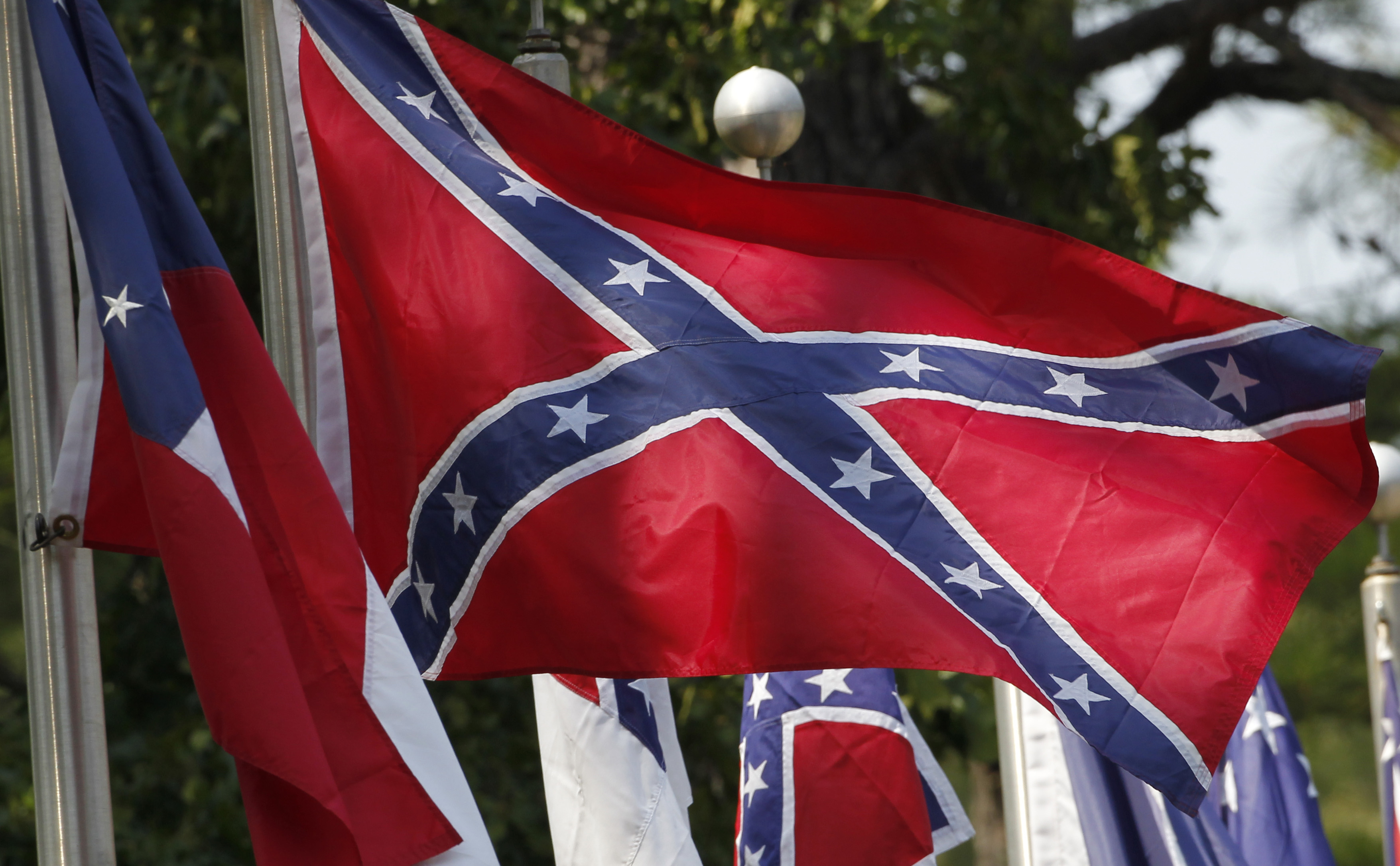The surprisingly uncomplicated racist history of the Confederate flag
The politics may be complicated. But the history is clear.


In the wake of a horrific mass shooting in Charleston, South Carolina, in which a young white man with an apparent history of racism is accused of killing nine black people during Bible study at a church, many are calling for the removal of the Confederate flag on statehouse grounds in South Carolina's capital. But the politics are tricky for Republicans in this conservative state. Last year, six in 10 South Carolinians said the flag should stay.
Now, the space between one's ears can get pretty easily fogged whenever politics mixes with race. So let's clarify some of the basic history about the Confederate Battle Flag, more accurately known as the Battle Flag of Northern Virginia.
The flag has no meaning "regardless" of politics, or above politics; its heritage is not exempt from history. Anyone can interpret anything any way they want, but if they claim historical sanction for their interpretation, then they'd best be accurate. And in that sense, history is clear: There is no revolutionary cause associated with the flag, other than the right for Southern states to determine how best to subjugate black people and to perpetuate slavery.
The Week
Escape your echo chamber. Get the facts behind the news, plus analysis from multiple perspectives.

Sign up for The Week's Free Newsletters
From our morning news briefing to a weekly Good News Newsletter, get the best of The Week delivered directly to your inbox.
From our morning news briefing to a weekly Good News Newsletter, get the best of The Week delivered directly to your inbox.
First sewn in 1861 — there were about 120 created for the war — the flag was flown by the cavalry of P.G.T. Beauregard, the Confederacy's first duly appointed general, after he took Manassas, Virginia, in the first Battle of Bull Run.
After the Civil War, the flag saw limited (and quite appropriate) use at first: It commemorated the sons of the South who died during the war. We can easily forgive the families of those who died for grieving. No account of the Civil War can be complete without noting how vicious the Union army could be, and how destructive its strategy toward the end of the war had become. That the cause of the war, once the damned Union army actually invaded the South and started destroying it, came to be associated with an actual, guns-out defense of real property and liberties — mainly, the liberty not to die during a war — is not controversial. That's what happens during wars.
But never did the flag represent some amorphous concept of Southern heritage, or Southern pride, or a legacy that somehow includes everything good anyone ever did south of the Mason-Dixon line, slavery excluded.
Fast-forward about 100 years, past thousands of lynchings in the South, past Jim Crow and Plessy v. Ferguson, past the state-sanctioned economic and political subjugation of black people, and beyond the New Deal that all too often gave privileges to the white working class to the specific exclusion of black people.
A free daily email with the biggest news stories of the day – and the best features from TheWeek.com
In 1948, Strom Thurmond's States' Rights Party adopted the Battle Flag of Northern Virginia as a symbol of defiance against the federal government. What precisely required such defiance? The president's powers to enforce civil rights laws in the South, as represented by the Democratic Party's somewhat progressive platform on civil rights.
Georgia adopted its version of the flag design in 1956 to protest the Supreme Court's ruling against segregated schools, in Brown v. Board of Education.
The flag first flew over the state capitol in South Carolina in 1962, a year after George Wallace raised it over the grounds of the legislature in Alabama, quite specifically to link more aggressive efforts to integrate the South with the trigger of secession 100 years before — namely, the storming of occupied Fort Sumter by federal troops. Fort Sumter, you might recall, is located at the mouth of Charleston Harbor.
Opposition to civil rights legislation, to integration, to miscegenation, to social equality for black people — these are the major plot points that make up the flag's recent history. Not Vietnam. Not opposition to Northern culture or values. Not tourism. Not ObamaCare. Not anything else.
There's only one uncontrived association that's a step removed from racial subjugation, and it's the initial post-war use of the flag: to celebrate the victories of the Confederate army and to mourn those who died while fighting in the Civil War. But today, 150 years later, such flags are best and most appropriate displayed in museums and at cemeteries.
It should not be controversial to say that people should not spend their days mourning relatives they never knew from a war that ended 150 years ago, especially if that feeling is so paramount that it outweighs the sense of brotherhood they might feel toward fellow humans who are alive, and for whom the flag's presence and endorsement by the government is the personification of the evil of white supremacy.
Marc Ambinder is TheWeek.com's editor-at-large. He is the author, with D.B. Grady, of The Command and Deep State: Inside the Government Secrecy Industry. Marc is also a contributing editor for The Atlantic and GQ. Formerly, he served as White House correspondent for National Journal, chief political consultant for CBS News, and politics editor at The Atlantic. Marc is a 2001 graduate of Harvard. He is married to Michael Park, a corporate strategy consultant, and lives in Los Angeles.
-
 Tea with Judi Dench: ‘touching’ show is must-watch Christmas TV
Tea with Judi Dench: ‘touching’ show is must-watch Christmas TVThe Week Recommends The national treasure sits down with Kenneth Branagh at her country home for a heartwarming ‘natter’
-
 Codeword: December 24, 2025
Codeword: December 24, 2025The daily codeword puzzle from The Week
-
 Crossword: December 24, 2025
Crossword: December 24, 2025The daily crossword from The Week
-
 Has Zohran Mamdani shown the Democrats how to win again?
Has Zohran Mamdani shown the Democrats how to win again?Today’s Big Question New York City mayoral election touted as victory for left-wing populists but moderate centrist wins elsewhere present more complex path for Democratic Party
-
 Millions turn out for anti-Trump ‘No Kings’ rallies
Millions turn out for anti-Trump ‘No Kings’ ralliesSpeed Read An estimated 7 million people participated, 2 million more than at the first ‘No Kings’ protest in June
-
 Ghislaine Maxwell: angling for a Trump pardon
Ghislaine Maxwell: angling for a Trump pardonTalking Point Convicted sex trafficker's testimony could shed new light on president's links to Jeffrey Epstein
-
 The last words and final moments of 40 presidents
The last words and final moments of 40 presidentsThe Explainer Some are eloquent quotes worthy of the holders of the highest office in the nation, and others... aren't
-
 The JFK files: the truth at last?
The JFK files: the truth at last?In The Spotlight More than 64,000 previously classified documents relating the 1963 assassination of John F. Kennedy have been released by the Trump administration
-
 'Seriously, not literally': how should the world take Donald Trump?
'Seriously, not literally': how should the world take Donald Trump?Today's big question White House rhetoric and reality look likely to become increasingly blurred
-
 Will Trump's 'madman' strategy pay off?
Will Trump's 'madman' strategy pay off?Today's Big Question Incoming US president likes to seem unpredictable but, this time round, world leaders could be wise to his playbook
-
 Democrats vs. Republicans: who do the billionaires back?
Democrats vs. Republicans: who do the billionaires back?The Explainer Younger tech titans join 'boys' club throwing money and support' behind President Trump, while older plutocrats quietly rebuke new administration
